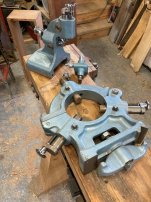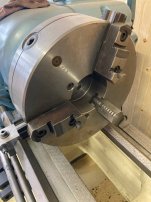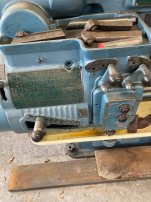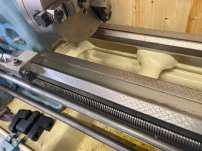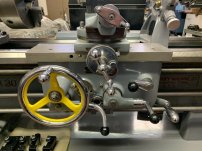morsetaper2
Diamond
- Joined
- Jul 2, 2002
- Location
- Gaithersburg, MD USA
Was looking over craigslist and saw this war era P&W 14x54 Model C lathe. Noticed the ways seem to be scraped. I would have thought they would have been hardened and ground and w/o scraping. Perhaps during the war some were shipped w/ soft ways that were scraped?
Lathe looks like it's lived an easy life. All the placards are in great shape and not beat up. And overall doesn't seem to show 80 years of use from the pictures. Could be a nice machine, I don't really know. I don't have the room for it at my small shop.
Was more curious about the ways?
S/N puts it likely 1944/45-ish
Text of CL listing:
"Pratt&Whitney 14”x54” Model C Engine Lathe.
Lathe is 5hp 240v 3 phase equipped with brand new 12” Bison 3 jaw chuck . Has a 12” 4 jaw . Both are D-6 mount . Lathe has these factory OEM items . Taper attachment , steady rest, follower test, micrometer bed stop , large face plate , driver plate , drill chuck, live center , dead center , Dorian CXA Tool post and 4 holders , lantern style tool post with holders , indicator bed stop .
Not much is needed to be off and running."
Pictures for posterity:
Lathe looks like it's lived an easy life. All the placards are in great shape and not beat up. And overall doesn't seem to show 80 years of use from the pictures. Could be a nice machine, I don't really know. I don't have the room for it at my small shop.
Was more curious about the ways?
S/N puts it likely 1944/45-ish
Text of CL listing:
"Pratt&Whitney 14”x54” Model C Engine Lathe.
Lathe is 5hp 240v 3 phase equipped with brand new 12” Bison 3 jaw chuck . Has a 12” 4 jaw . Both are D-6 mount . Lathe has these factory OEM items . Taper attachment , steady rest, follower test, micrometer bed stop , large face plate , driver plate , drill chuck, live center , dead center , Dorian CXA Tool post and 4 holders , lantern style tool post with holders , indicator bed stop .
Not much is needed to be off and running."
Pictures for posterity:
Attachments
-
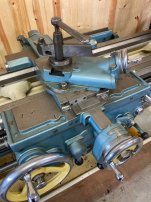 00b0b_eJa3ca1PE19_0t20CI_1200x900.jpg98.2 KB · Views: 65
00b0b_eJa3ca1PE19_0t20CI_1200x900.jpg98.2 KB · Views: 65 -
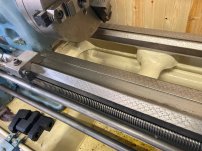 00e0e_hKv9NG3g01t_0CI0t2_1200x900.jpg155.9 KB · Views: 61
00e0e_hKv9NG3g01t_0CI0t2_1200x900.jpg155.9 KB · Views: 61 -
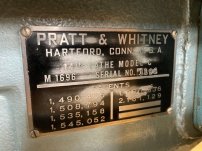 00O0O_lc6eDjvNdds_0CI0t2_1200x900.jpg148.2 KB · Views: 53
00O0O_lc6eDjvNdds_0CI0t2_1200x900.jpg148.2 KB · Views: 53 -
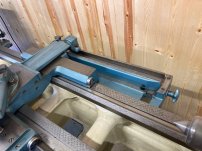 00P0P_9g8xIq5ImCO_0CI0t2_1200x900.jpg142.2 KB · Views: 50
00P0P_9g8xIq5ImCO_0CI0t2_1200x900.jpg142.2 KB · Views: 50 -
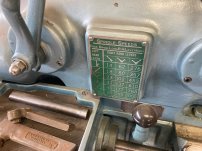 00Q0Q_3fwDtzjSH2r_0CI0t2_1200x900.jpg155.2 KB · Views: 57
00Q0Q_3fwDtzjSH2r_0CI0t2_1200x900.jpg155.2 KB · Views: 57 -
 00U0U_bejCOUhKvhJ_0CI0rv_1200x900.jpg150.4 KB · Views: 59
00U0U_bejCOUhKvhJ_0CI0rv_1200x900.jpg150.4 KB · Views: 59 -
 00Z0Z_7dlyZhOXLSo_0t20CI_1200x900.jpg98.1 KB · Views: 59
00Z0Z_7dlyZhOXLSo_0t20CI_1200x900.jpg98.1 KB · Views: 59 -
 00303_b2BZz6rzuQH_0CI0t2_1200x900.jpg161.8 KB · Views: 56
00303_b2BZz6rzuQH_0CI0t2_1200x900.jpg161.8 KB · Views: 56
Last edited:


